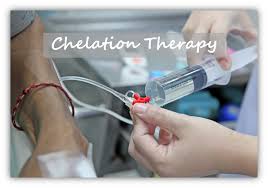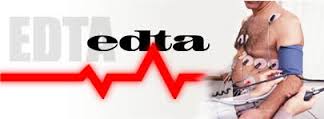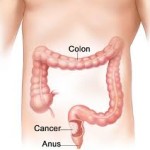 Chelation therapy is a treatment used by traditional medicine physicians to treat heavy metal poisoning. The scientific medical name is ethylene diamine tetraacetic acid or EDTA. (1) However, it is also a term used in alternative medicine reportedly helpful in treating heart disease, cancer and other conditions. (2)
Chelation therapy is a treatment used by traditional medicine physicians to treat heavy metal poisoning. The scientific medical name is ethylene diamine tetraacetic acid or EDTA. (1) However, it is also a term used in alternative medicine reportedly helpful in treating heart disease, cancer and other conditions. (2)
The term “chelation” comes from the Greek word chele, which means “claw”. This actually refers to the way in which the chemicals in the EDTA grab onto the metals in the body and help the body to excrete them so they are no longer toxic. Chelation therapy is an effective treatment for lead poisoning because the EDTA binds to the lead in the body and flushes it out through the kidneys.
The use of EDTA has been approved by the US Food and Drug Administration as a treatment for lead poisoning. The human body cannot break down heavy metal, such as lead, and can build up toxic levels in the body which interfere with normal functioning of the neurological system as well as other organ systems. It is also used in the treatment of mercury, cadmium and zinc overdoses.
The use of EDTA in the treatment of atherosclerosis developed when scientists and researchers discovered that the treatment reduced the amount of calcium in the bloodstream. Some practitioners believed that this reduction in calcium would lead to a re-opening of arteries that were blocked by mineral deposits. This is often called atherosclerosis or hardening of the arteries. Alternative medicine physicians were excited about the use of EDTA for the treatment of hardening of the arteries because it was less expensive than coronary bypass surgery, angioplasty or other techniques used to unclog blocked arteries. (3)
The theory behind the use of EDTA was that once the calcium was removed from the bloodstream the remaining elements in the plaque would break up and clear away. This would allow the arteries to reopen and restore them to their former state. Based upon this thinking and theory some physicians also use chelation therapy to prevent atherosclerosis from forming.
However, after carefully reviewing the scientific literature the American Heart Association has concluded that there are no benefits to this form of therapy and do not currently recommend chelation therapy as a way of preventing or treating atherosclerosis. The concern that the American Heart Association has is both with the lack of clinical evidence and the claims made by holistic medicine physicians that chelation therapy can treat and prevent atherosclerosis. (4)
 There are ample testimonials from individuals who have used chelation therapy and believe that they feel better after treatments. Unfortunately, because there were no strictly enforced clinical trials the question becomes why these individuals feel better. For instance, for a physician to recommend chelation therapy usually requires an individual to make significant lifestyle changes that can include quitting smoking, losing weight, improving nutrition, exercising regularly and making better lifestyle choices. Is it the lifestyle choices that made the individual feel better or the chelation therapy?
There are ample testimonials from individuals who have used chelation therapy and believe that they feel better after treatments. Unfortunately, because there were no strictly enforced clinical trials the question becomes why these individuals feel better. For instance, for a physician to recommend chelation therapy usually requires an individual to make significant lifestyle changes that can include quitting smoking, losing weight, improving nutrition, exercising regularly and making better lifestyle choices. Is it the lifestyle choices that made the individual feel better or the chelation therapy?
Unfortunately, EDTA is not completely safe as a drug. While it is safe in the very short term as a means of getting rid of lethal heavy metals within the body there is a very real danger of kidney failure and bone marrow depression. Other individuals have reported low blood pressure, convulsions, cardiac arrhythmias and respiratory arrest. (5)
Individuals who are receiving chelation therapy for the treatment of heavy metals often receive the drugs through a vein or as a short injection. A typical treatment can include 20 injections or infusions spread out over 10 to 12 weeks depending upon the levels of heavy metals in the body. Chelation can also be given by mouth when physicians recommend 20 to 40 treatments. However some have recommended up to 100 over a period of several years which places the kidneys at a severe risk.
Chelation therapy has its risks but the benefits outweigh those risks when the individual is suffering from heavy metal poisoning. This poisoning often brings with it risk of death as well as permanent neurological damage and degeneration. However, when an individual is using chelation therapy in order to treat atherosclerosis or prevent some unknown problem or disease the risk of using EDTA now outweighs any potential benefits which the individual may or may not experience.
While using these substances is a choice that you must make on an individual basis, it is in your best interest to do your own research on the risk versus benefit ratio before making a decision based on the recommendations of a practitioner or physician. After all, it is your body that is being affected by a preventative treatment and not the body of your practitioner or physician.
References:
(1) Center for Occupational and Environmental Medicine: Chelation Therapy
http://www.coem.com/programstreatment_ChelationTherapy.shtml
(2) National Center for Complementary and Alternative Medicine: Chelation Therapy for Coronary Artery Disease
http://nccam.nih.gov/health/chelation
(3) MayoClinic.com: Chelation Therapy for Heart Disease
http://www.mayoclinic.com/health/chelation-therapy/MY00159
(4) Circulation: Chelation Therapy for Peripheral Arterial Occlusive Disease
http://circ.ahajournals.org/content/96/3/1031.full
(5) Center for Disease Control and Prevention Morbidity and Mortality Weekly Report: Deaths Associated with Hypocalcemia from Chelation Therapy — Texas, Pennsylvania, and Oregon, 2003–2005
http://www.cdc.gov/mmwr/preview/mmwrhtml/mm5508a3.htm


Leave a Reply